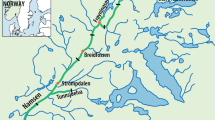Synopsis
We tagged both wild and hatchery Atlantic salmon, Salmo salar, smolts from River Ellidaar (64 ° 08′ N, 21 ° 50′ W) with ultrasonic tags. We caught the wild smolts in a smolt trap and selected the largest individuals from the run. We implanted the transmitters in the abdominal cavity of the fish and then released them in River Ellidaar close to the estuary. We used four ultrasonic receivers; one in the river’s estuary, one outside the estuary and two further away on both sides of an island in the estuary zone. The receivers recorded all transmitters within a 600 m radius. The hatchery smolts were larger than the wild smolts. Some of the smolts were lost on the way through the estuary. Only 4 out of 9 wild smolts and 14 of 17 hatchery smolts were recorded all the way through. The tags and the tagging likely affected the survival of the smolts especially the smaller fish. There were no differences in the smolt migration between the 2 years of study and no differences in the migration behavior between the wild and the hatchery smolts. After being released the smolts stayed on average for 10 h in the river then migrated into the estuary were they stayed for 54 h on average. Then they migrated straight through the area to the sea at approximately 0.2 fish lengths per second. We recorded large differences in the migration.
Similar content being viewed by others
References
N.S. Adams D.W. Rondorf S.D. Evans J.E. Kelly R.W. Perry (1998a) ArticleTitleEffects of surgically and gastrically implanted radio transmitters on swimming performance and predator avoidance of juvenile chinook salmon (Oncorhynchus tshawytscha) Can. J. Fish. Aquat. Sci. 55 781–787 Occurrence Handle10.1139/cjfas-55-4-781
N.S. Adams D.W. Rondorf S.D. Evans J.E. Kelly R.W. Perry (1998b) ArticleTitleEffects of surgically and gastrically implanted radio transmitters on growth and feeding behaviour of juvenile chinook salmon Trans. Am. Fish. Soc. 127 128–136 Occurrence Handle10.1577/1548-8659(1998)127<0128:EOSAGI>2.0.CO;2
Th. Antonsson S. Gudjonsson (2002) ArticleTitleVariability in timing and characteristics of Atlantic salmon smolt in Icelandic rivers Trans. Am. Fish. Soc. 131 643–655 Occurrence Handle10.1577/1548-8659(2002)131<0643:VITACO>2.0.CO;2
Gudjonsson, S., I.R. Jonsson, Th. Antonsson & J. Sturlaugsson. 2002. Rannsoknir a farleidum og gonguatferli laxfiska a osasvaedi Ellidaanna 2001 og 2002. Institute of Freshwater Fisheries. Report VMSTR/0220. 17pp. In Icelandic
M. Holm J.C. Holst L.P. Hansen (2000) ArticleTitleSpatial and temporal distribution of post-smolts of Atlantic salmon (Salmo salar L.) in the Norwegian Sea and adjacent areas ICES J. Marine Sci. 56 200–208
Holm, M., B. Axelsen, N.A. Hvidsten, E. Ikonen, B.O. Johnsen & J. Sturlaugsson. 1997. Salmon migration in the Trondheimfjord – 1996 experiences with monitoring acoustically tagged postsmolts with sonar. Second Conference on Fish Telemetry in Europe. Trondheim
J.C. Holst G.J. Shelton M. Holm L.P. Hansen (2000) Distribution and possible migration routes of postsmolt Atlantic salmon in the North-east Atlantic.65 – 74 D. Mills (Eds) The Ocean Life of Atlantic Salmon; Environmental and Biological Factors Influencing Survival. Fishing News Books Blackwell Science Oxford
N.A. Hvidsten R.A. Lund (1988) ArticleTitlePredation on hatchery-reared and wild smolts of Atlantic salmon, Salmo salar L., in the estuary of River Orkla, Norway J. Fish Biol. 33 121–126
G.L. Lacroix P. McCurdy (1996) ArticleTitleMigratory behaviour of post-smolt Atlantic salmon during initial stages of seaward migration J. Fish Biol. 49 1086–1101 Occurrence Handle10.1111/j.1095-8649.1996.tb01780.x
D. Mills (1989) Ecology and Management of Atlantic Salmon Chapman and Hall London 351
D.L. Scarnecchia (1984) ArticleTitleClimatic and oceanic variations affecting yield of Icelandic stocks of Atlantic salmon (Salmo salar) Can. J. Fish. Aquat. Sci. 41 917–935 Occurrence Handle10.1139/f84-147
Sturlaugsson, J. & K. Thorisson. 1995. Postsmolts of ranched Atlantic salmon (Salmo salar L.) in Iceland II. The first days of the sea migration. ICES CM. 1995/M: 15
J.E. Thorpe (1988) ArticleTitleSalmon migration Sci. Prog. 72 345–370
F.A. Voegeli G.L. Lacroix J.M. Anderson (1998) ArticleTitleDevelopment of miniature pingers for tracking Atlantic salmon smolts at sea Hydrobiologia 371 – 2 35–46
D.W. Welch G.W. Boehlert B.R. Ward (2003) ArticleTitlePOST-the Pacific Ocean salmon tracking project Oceanol. Acta 25 243–253
D.W. Welch B.R. Ward S.D. Batten (2004) ArticleTitleEarly ocean survival and marine movements of hatchery and wild steelhead trout (Oncorhynchus mykiss) determined by an acoustic array: Queen Charlotte Strait, British Columbia Deep Sea Res. 51 897–909
Author information
Authors and Affiliations
Corresponding author
Rights and permissions
About this article
Cite this article
Gudjonsson, S., Jonsson, I.R. & Antonsson, T. Migration of Atlantic Salmon, Salmo salar, Smolt through the Estuary Area of River Ellidaar in Iceland. Environ Biol Fish 74, 291–296 (2005). https://doi.org/10.1007/s10641-005-0500-0
Received:
Accepted:
Issue Date:
DOI: https://doi.org/10.1007/s10641-005-0500-0




